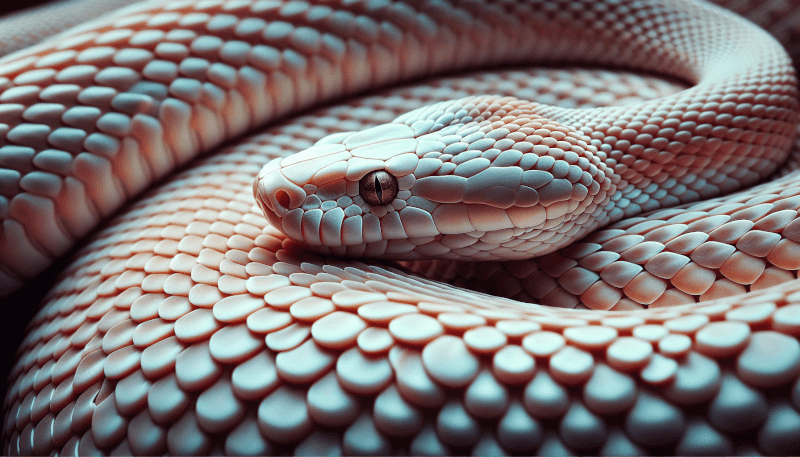Imagine encountering a snake that isn’t the typical dark and menacing reptile you often associate with these creatures. Picture a snake with light colors that gracefully blend with its surroundings, creating a captivating spectacle of nature. In this article, we will discover the fascinating world of light-colored snakes and explore the beauty that lies within their unique appearance.

Importance of Snake Coloration
Snake coloration plays a crucial role in the survival and success of these reptiles. It serves two primary purposes: natural selection and camouflage, and communication and warning signals.
Natural selection and camouflage
In nature, survival is all about the ability to blend into the environment and go unnoticed. Snakes with light coloration have evolved to match their surroundings, allowing them to conceal themselves from potential predators and unsuspecting prey. This cryptic coloration is essential for their survival as it enables them to ambush their prey effectively while remaining hidden from predators.
Communication and warning signals
Snake coloration also serves as a means of communication and signaling. Some light-colored snakes have vibrant patterns and markings that serve as warnings to potential predators, indicating their venomous nature or indicating their presence. These warning signals help deter predators and prevent potentially dangerous encounters.
Causes of Light Coloration in Snakes
Several factors contribute to the light coloration exhibited by certain snake species. These include genetics and inheritance, as well as habitat and environmental factors.
Genetics and inheritance
Genetic factors play a significant role in determining the coloration of snakes. Certain genes can influence the production of pigments, resulting in lighter colors in some individuals. These genetic traits can be passed down from generation to generation, leading to the prevalence of light-colored snakes within particular species or lineages.
Habitat and environmental factors
The environment in which a snake resides can also influence its coloration. Snakes that inhabit sandy or arid regions may develop lighter colors as an adaptation to their surroundings, allowing them to blend in more effectively. Similarly, snakes living in areas with dense vegetation may exhibit green or yellow coloration, enhancing their camouflage among leaves and vegetation.
Common Light Colored Snake Species
There are various snake species known for their light coloration. Here are a few examples:
Albino Burmese Python
The Albino Burmese Python is a popular snake species known for its stunning light coloration. These pythons lack any pigmentation, resulting in their characteristic white or pale yellow appearance. They are highly sought after by snake enthusiasts and often kept as pets.
Leucistic Texas Rat Snake
The Leucistic Texas Rat Snake is another light-colored snake species. Leucism is a genetic condition that affects pigmentation, resulting in a snake that appears entirely white or pale. This snake species is native to the southern parts of the United States and is admired for its unique appearance.
Pale-headed Snake
The Pale-headed Snake, also known as the Brown-headed Snake, is a venomous snake species found in Australia. Despite its name, this snake exhibits a light coloration, with a pale or light brown head. It is known for its small size and docile nature, making it a fascinating species to observe.
Adaptations for Survival
Light-colored snakes have developed various adaptations to enhance their survival in their respective environments. These adaptations include cryptic coloration, heat regulation, and predator avoidance.
Cryptic coloration
Cryptic coloration is a common adaptation exhibited by light-colored snakes. By blending in with their surroundings, they can effectively conceal themselves from potential predators and prey. This camouflage allows them to remain undetected and increases their chances of successful hunting.
Heat regulation
Snakes are ectothermic creatures, meaning they rely on external heat sources to regulate their body temperature. Light-colored snakes, particularly those inhabiting sun-drenched areas, benefit from their light coloration as it helps reflect sunlight and reduce heat absorption. This adaptation allows them to maintain optimal body temperature for physiological functions.
Predator avoidance
Light-colored snakes also employ specific behaviors and strategies to avoid becoming prey. They may rely on their cryptic coloration to hide from predators or use quick movements and defensive displays to deter them. Some light-colored snakes may mimic the appearance of more venomous or dangerous species, fooling potential predators into thinking they are not worth the risk.
Role of Light Coloration in Predatory Strategies
Light-colored snakes utilize their coloration to optimize their predatory strategies. By taking advantage of their light appearance, they can effectively ambush prey and appear less threatening.
Ambushing prey
Camouflaged in their light colors, these snakes are masters of surprising their prey. They patiently wait for the perfect moment to strike, capitalizing on their ability to blend into their surroundings. This predatory strategy allows them to effectively capture unsuspecting prey and increases their chances of a successful hunt.
Appearing less threatening to prey
In some instances, light-colored snakes may utilize their appearance to appear less intimidating to potential prey. Prey animals often associate vibrant or contrasting colors with danger. By adopting a lighter coloration, these snakes can reduce the perceived threat level and increase their chances of successful hunting.
Cultural and Symbolic Meanings
Light-colored snakes hold significance in various mythologies and cultural beliefs. They often symbolize different concepts and have diverse meanings across different cultures.
Light-colored snakes in mythology
In Greek mythology, snakes were seen as symbols of transformation and regeneration. The myth of the ouroboros, a snake devouring its tail, represents eternal cycles of life and death. Light-colored snakes, in particular, may symbolize purity, renewal, and spiritual awakening.
Symbolism in different cultures
In many cultures, light-colored snakes hold symbolic meanings tied to their coloration. In some Native American traditions, the white snake is associated with healing and purification. In Chinese culture, the white snake is seen as a benevolent creature and symbolizes good fortune and prosperity. These cultural beliefs and associations continue to shape our perceptions and interpretations of light-colored snakes.
Human Reactions and Perceptions
The appearance of light-colored snakes often elicits strong reactions and perceptions among humans. These reactions can range from fear and aversion to interest and fascination.
Fear and aversion
Due to cultural and personal associations, many individuals harbor a fear of snakes, regardless of their coloration. Light-colored snakes may be particularly unsettling for some, as their pale appearance can stand out and draw attention. This fear and aversion often stem from a lack of understanding and misinformation surrounding these fascinating reptiles.
Interest and fascination
On the other hand, many people find light-colored snakes captivating and intriguing. Their unique appearance and the mystery surrounding them can spark curiosity and interest. Snake enthusiasts and herpetologists often dedicate their time to studying and appreciating the beauty and complexity of these creatures, shedding light on their importance within ecosystems.
Conservation Efforts and Threats
Light-colored snakes, like all snake species, face various conservation challenges and threats to their survival. These include illegal pet trade and habitat loss.
Illegal pet trade
Some light-colored snakes, such as the Albino Burmese Python, have gained popularity within the exotic pet trade. Unfortunately, this trade often operates illegally, resulting in the exploitation and detrimental impact on wild populations. Captive breeding programs and responsible ownership are crucial in combating this threat and ensuring the long-term survival of these species.
Habitat loss
Habitat destruction and fragmentation pose a significant threat to light-colored snakes. As their natural habitats are destroyed or altered, their chances for survival diminish. Conservation efforts should focus on preserving and restoring their habitats, ensuring the availability of suitable environments for these snakes to thrive.
Unique Features of Light Colored Snakes
Beyond their coloration, light-colored snakes can exhibit other unique features that add to their allure.
Eye color variations
Light-colored snakes often display a wide range of eye colors, adding to their visual appeal. Some have striking blue or gray eyes, while others may have silver or pale yellow eyes. These unique eye colors are a result of genetic variations and can further fascinate admirers of these remarkable reptiles.
Pattern abnormalities
In some cases, light-colored snakes may exhibit pattern abnormalities, such as missing or distorted patterns. These variations often occur due to genetic mutations or developmental factors. While these patterns may deviate from the norm, they serve as a testament to the biological diversity and individuality of each snake.
Breeding and Maintenance of Light Colored Snakes
Breeding and maintaining light-colored snakes require specialized knowledge and care. Selective breeding and proper husbandry practices are essential to ensure the health and well-being of these unique reptiles.
Selective breeding
Selective breeding programs play a significant role in producing and maintaining light-colored snakes, such as the Albino Burmese Python and Leucistic Texas Rat Snake. Breeders carefully select individuals with desired color traits to achieve specific breeding goals. This practice helps preserve and enhance the diversity of light-colored snake populations in captivity.
Proper care and husbandry
Light-colored snakes have specific care requirements that must be met to ensure their well-being. Owners must provide suitable enclosures, appropriate temperatures, and a balanced diet. Regular health check-ups and monitoring are also essential for maintaining the health of these captivating reptiles.
In conclusion, the importance of snake coloration cannot be understated. Light-colored snakes have evolved their appearance to optimize their survival in various environments. From camouflaging with their surroundings to effectively communicating with potential predators or prey, their coloration plays a vital role in their lives. Beyond their biological significance, light-colored snakes hold cultural, symbolic, and aesthetic value. However, the threats they face, such as habitat loss and illegal pet trade, highlight the need for conservation efforts to protect and preserve these unique reptiles for future generations.


